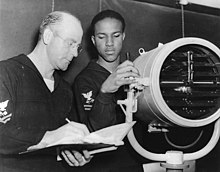This article includes a list of references, related reading, or external links, but its sources remain unclear because it lacks inline citations. (November 2020) |

A signal lamp (sometimes called an Aldis lamp or a Morse lamp[1]) is a visual signaling device for optical communication by flashes of a lamp, typically using Morse code. The idea of flashing dots and dashes from a lantern was first put into practice by Captain Philip Howard Colomb, of the Royal Navy, in 1867. Colomb's design used limelight for illumination, and his original code was not the same as Morse code. During World War I, German signalers used optical Morse transmitters called Blinkgerät, with a range of up to 8 km (5 miles) at night, using red filters for undetected communications.
Modern signal lamps produce a focused pulse of light, either by opening and closing shutters mounted in front of the lamp, or by tilting a concave mirror. They continue to be used to the present day on naval vessels and for aviation light signals in air traffic control towers, as a backup device in case of a complete failure of an aircraft's radio.